Sacred Ganesha Festivals
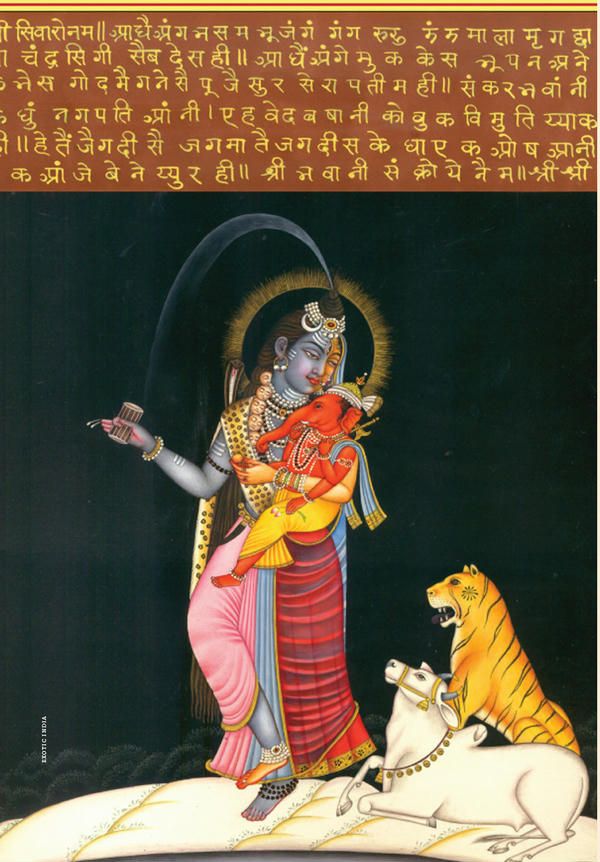
OPULENT HINDU FESTIVALS ARE TIMES OF JOYOUS celebration marked by special observances. There are many festivals each year, several to each of the Gods. In this section we present the major festivals that honor Lord Ganesha. Some are celebrated in the temple and others primarily in the home and village. Each of Hinduism’s major denominations has its special festivals, and all share in certain celebrations. Each festival occurs at approximately the same time of year, varying slightly according to astrological calculations, usually based on the lunar calendar. Festivals are characterized by acts of piety — penance, fasting, pilgrimage — and spiritual rejoicing: singing, dancing, musical performance, parades, storytelling, scripture-reading and elaborate pujas.
Ganesha Chaturthi
Ganesha Chaturthi, also known as Vinayaka Chaturthi, is the festival day celebrating the birth of Lord Ganesha. One of the great national festivals of India, and the foremost annual festival to Ganesha, it is celebrated on the chaturthi or “fourth day” after the new moon in the Tamil month of Avani (August-September). We decorate the temple and home shrine with banana leaves, sugarcane and strings of mango leaves, making it look like a small forest. We bring baskets of fruits and sweets, especially modaka balls, and place them before the sanctum of Lord Ganesha. He receives special pujas throughout the day and often a festival parade. Each year we obtain or make a small or large soft clay image of Ganapati and use it for worship at home for two to ten days after Ganesha Chaturthi. Pandit Arunachalam notes: “In Karnataka, India, young people make a ritual of seeing 108 Vinayakas on this occasion, so they go about visiting their friends’ and relatives’ houses on this day….The worship of Ganesha on this day is supposed to confer advancement in learning to the young student and success in any enterprise undertaken” (Festivals of Tamil Nadu, p. 110-121).
Shri Arunachalam continues with a description of the Chaturthi Puja itself: “The worship, or puja, is done as usual towards the close of the forenoon. The whole house and the entrance are decorated with kolam. Festoons are hung ’round the place of worship, making it into a sort of decorated mandapam, or hall. Tender coconut leaves, split and artistically designed, white in color, mango leaves dark green, lilies in white, and pink and crimson festoons present a colorful appearance. The newly made clay image is placed facing east in a convenient place in the northern part of the house on a pedestal decorated in kolam design of an eight-petalled padma (lotus flower). On the padma a small quantity of paddy (uncooked rice) is spread, and the Ganesha image is placed on it over a plantain leaf. Only white flowers are used for the worship. Aruhu and erukku are special favorites. Then all the puja rituals are gone through fully.
“Besides, the fruits of the season, such as the wood apple and jambu (naval), are also offered in plenty along with the customary plantain fruits and coconuts…. Usually in the rural parts, a puja is performed again the next morning or noon (punarpuja) with fresh food offerings. In the evening, the Ganesha image is carried by the boys, along with the flowers, and consigned to a running stream or to a good water pool or tank. So, Ganesha who was shaped out of the earth, is now returned to the same earth.” This is a day for rejoicing and for seeking the blessings of the Lord of Obstacles to bring wealth and success into our life.
Ganesha Visarjana
Ganesha Visarjana (a Sanskrit word meaning “departure”) names the Ganesha Chaturthi immersion ceremony. Especially in Maharashtra state, it takes place ten days after Ganesha Chaturthi; though in some areas Visarjana is done even on the Chaturthi day itself. It is a ceremony of fond farewell to a beloved God. On Chaturthi day we celebrate Ganesha’s birthday and then honor Him as our beloved guest for ten days. Then on the tenth day, called chaturdashi, we bid Him fond farewell at the ocean shore or banks of a river or babbling brook of love and watch Him float off on the conveyance we have prepared for Him until He finally disappears from sight into the waters. We honor His departure with a grand parade, as we carry Him on a palanquin bedecked with flowers and accompanied by puja, music, dancing and celebration. Clay images of Ganesha specifically prepared for the event are ceremoniously dissolved in the ocean or other body of water at this time by devotees all over the world, signifying Ganesha’s withdrawal into all-pervasive consciousness. Though the Visarjana has been celebrated as a religious festival for thousands of years, it became especially popular early in this century.
Shri S.K. Deodhar explained the popularity of the Visarjana festival in HINDUISM TODAY, July, 1988: “Lokmanya Tilak from Maharashtra, who first raised the banner for Indian independence and freedom from British rule, gave the call around 1910 to celebrate the Ganesha festival as a public puja, so as to mobilize people to come together to build up a strong, united India, based on her holy traditions and scriptural teachings. Since then, people observe the festival, both at home and in public, with options of one and one-half days to 5, 7 or 10 days. The tenth day is Ananta Chaturdashi, which coincides with the puja to Ananta, the Holy Serpent.
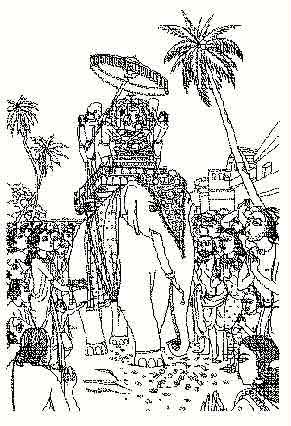
“The tenth-day immersion procession is truly spectacular in many cities, when thousands of idols are taken to the sea or river with a lot of music, dance, rejoicing, street-chariots and decorations. These continue often throughout the tenth night, up to the eleventh day morning. The celebration consists of bringing an earthen idol from the market and doing puja in the traditional style as you would do for a respected guest who comes to your home. When it is time for a guest to depart, we offer him gifts and food for his travel. Then we accompany him up to the border of the village, which is often a small stream or rivulet. As the guest enters the water of the stream, we bid him goodbye and return home. This old tradition is observed in the Ganesha festival, by immersing the earthen idol in the river, sea or tank. The observance was originally for one and one-half days: bringing the idol on the first day, doing the puja, rejoicing, and immersing it on the second day. But later many people increased the period to celebrate the festival with more joy, devotion, music, religious talks, etc. The Indian state of Maharashtra is renowned for its Visarjana festivals which each year draw millions of participants, most notably in the cities of Bombay and Pune.” (Shri Deodhar’s description was translated from Gujarati by Shri Vinayak Vishwanath Gokhale.)
It is well known that Lord Ganesha has a knack for bringing devotees together, and the Visarjana is one of the ways that He does this. All forget their daily concerns, worries and personal lives during this celebration and gather with others in the fun. In 1988 Ganesha broke new ground in his public relations when Visarjana was held in the United States. It was the first large-scale interdenominational public Hindu festival held in US history. It was indeed an historic event. Almost two thousand Hindus gathered in San Francisco, California, on September 25 for a grand festival culminating ten days of worship and festivities begun on Ganesha Chaturthi. More than twenty Hindu organizations of various traditions participated against the majestic backdrop of the Golden Gate Bridge. Horns sounded, drums played and bells rang out pujas as hundreds of images of Ganesha were dramatically conveyed to the Pacific Ocean. Many worshipers stated with delight that they felt as if they were back in India. The celebration proved to one and all that Hinduism had reached a new level of maturity in the US, as devotees boldly proclaimed their faith in such a grand public ceremony. The festival has been held in the San Francisco Bay Area every year since its inception. Australia followed suit a few years later, and now yearly parades are held on the streets of Sidney by all Hindu groups joining together in public worship.
Making Clay Ganeshas
Pandit Arunachalam provides an excellent description of the joyful activity of making clay Ganeshas: “The form of Ganesha is a delight not only to the artist and the sculptor but also to the children….Almost all the children try their hand at producing the complete form of Ganesha in clay with their own hands — the full elephant face with its trunk curved at the tip, four hands, the uplifted ones carrying the goad and the noose, the left hand carrying the modaka, the right in the pose of offering benediction, the big belly with the sacred thread thrown across the left shoulder, the two stumpy legs, and not omitting His mount, the little shrew [mouse]. The scarlet black-eyed seeds of the creeper kunrimani (the crab’s eye, Abrus precatorius) serve as the eyes of Ganesha. In places like Madras, a slender paper umbrella is added.
“The clay image is made at the moment in the morning. In urban areas, people purchase it. But in the rural parts it is the pride of the urchins to make the image each for the family worship. The boys vie with one another in making the image perfect, i.e., in making it conform to what is known as the Ravi Varma picture as closely as possible. Rules lay down that the image is made out of the mud of the ants’ hill. In urban areas, hand-made supply cannot keep up with the demand. So the makers have wooden moulds on which they hand-press the kneaded clay and cast the images.”
THE PROPER ATTITUDE
Making an image of the God must be done in the right spirit. Swami Satyananda Saraswati of Devi Mandir in California contributes the following instruction.
“Take all of the love in your heart, all the longing to see God face to face, the totality of your aspiration for Self Realization, mix it with straw and earth and watch as the divine image takes shape within your very proximity.
“Give form to your longing, that heartfelt desire to know the Divine immediately and directly, to experience the divine presence in intimate contemplation, and see how all the elements — earth, water, fire and air — unite from the infinite expanse of nature in order to form an image of Divinity, the reflection of God.
“Remember the difference between trying to make a statue and praying for the murti of God to manifest through us. Meditate upon the various attributes, and put your mind into the fullness of bhava, the attitude of the Deity.
“Let all the peace, all the light, all the goodness which the Deity inspires become part and parcel of your being. Inwardly worship the Deity, reciting the mantras and contemplating His subtle form.
“Smile at that internal murti and with the utmost sincerity request permission from God to make that divine form manifest in a manner all can perceive.
“When the image takes form, find all the love and devotion you can offer and breathe the soul of life into your image of God, praying for the blessings of wisdom and peace for all.”
A SIMPLE METHOD FOR A WOOD-BASED GANESHA
By Shri Sateesh N. Apte M.D., Danville, California
The materials needed for a wood-based clay Ganesha are: 1)clay (either professional sculptor’s clay or that gathered from a river bed) or papier mache; 2) latex or other water-based paint in yellow, red, black and flesh colors; 3) gold-leaf paint, 4) aluminum foil, 5) paint brushes, 6) sandpaper, 7)putty or joint compound, 8) miscellaneous ornaments and cloth for dressing the murti.
INSTRUCTIONS
1. Mix clay or papier mache to a firm but homogeneously wet consistency.
2. Make an armature (skeleton) of wood, styrofoam or similar material.
3. Create the image by covering the armature with clay.
4. Brush the exterior smooth with a wet brush.
5. Let the image dry in a cool place, away from the sunlight. (Drying time is usually one month for every foot in height for a clay image, three weeks for papier mache.)
6. When dry, sand with coarse, then fine sandpaper.
7. Fill cracks with putty or joint compound. Sand again.
8. Apply a white primer and sand with very fine sandpaper.
9. Make the image dust-free.
10. Paint the torso, head, trunk and limbs in flesh color.
11. Place appropriate dress (traditionally white or red silk) upon the image.
12. Paint the crown gold and the hair and eyes black.
13. Draw three stripes of vibhuti on the forehead and a swastika and an Aum on the abdomen with red paint and a fine brush.
14. Make implements for each hand out of aluminum foil.
15. Decorate the image with ornaments, flowers, etc.
Vinayaka Vratam
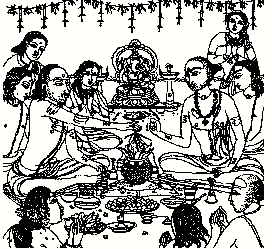
Vinayaka Vratam is a 21-day festival honoring Lord Ganesha beginning on the full moon day in the month of Karttikai — November/December. During these days Vinayaka Purana, or stories, are recited in the temples, and special pujas are conducted at every Ganesha temple. Many devotees observe the vrata (vow) of attending daily puja at a Ganesha temple and taking only one meal a day, in the evening.
Markali Pillaiyar
Markali Pillaiyar is a month-long home religious festival held in honor of Lord Ganesha. For untold thousands of years winter festivities and ceremonies have been held in His honor. During the Tamil month of Markali — from mid-December to the mid-January — we worship Lord Pillaiyar, the Noble Child, with special devotion, prayers and japa of His names. This month is the most spiritual time of the year, and we meditate diligently, especially between four and six in the morning. Traditionally, all worship, prayer and spiritual disciplines, or sadhanas, are commenced during the month of Markali, and the home is cleaned each day.
Pancha Ganapati
Pancha Ganapati is a modern Hindu festival of the Five-Faced (pancha means “five”) Maha Ganapati — Lord of Categories. This festival falls during the thirty days of the Markali Pillaiyar home festival and lasts for five days — from December 21 through 25.
The winter solstice has always been a festive time of year in all countries and religions, among Hindus especially, for it is a traditional season for the worship of Lord Ganesha. In Hindu Vedic Astrology this time of year marks the end of the sun’s southward movement and the beginning of its movement north, the change from dakshinayana to uttarayana. Since Hindus do not celebrate Christmas, they often find it difficult to relate in a meaningful way to those who do. Their children are often embarrassed when asked why they do not receive gifts on December 25. Adults feel the need to give gifts and mail greeting cards as well as receive them from their relatives, neighbors, friends and business associates. Pancha Ganapati is a Hindu expression of this natural season of worship, gift-giving and celebration.
December 25 and the days that precede and follow it have truly become a special time of year for people of many religions, and for the non-religious as well. In fact, this season has become so universally popular that it has virtually become a secular cultural holiday in addition to its special observance by certain religions. Recognizing this fact, the U.S. Supreme Court ruled Christmas a secular, social holiday. This is because it has become a time for everyone to rejoice, give and share their abundance, each in his own way.
CREATING THE PANCHA GANAPATI SHRINE
Pancha Ganapati is not a temple utsava; it is a contemporary home observance. Because of the importance of this festival as a new beginning and mending of all mistakes of the past, a festive shrine is created especially for the five-day event in the main living room of the home. At the center of the shrine is placed a large wooden or bronze five-faced statue of Lord Pancha Ganapati. If this is not available, any large picture of Lord Ganesha will do. The home shrine is decorated in the spirit of this festive season. Lord Ganesha is often depicted as coming from the forest; therefore, pine boughs (or banana leaves) may be used. Durva grass, sugarcane and garlands of sweet modaka balls are used to decorate the home shrine. Flashing lights, tinsel and colorful hanging ornaments may also be added.
Pancha Ganapati is dressed anew each morning, preferably by the children, in a special color for that particular day. His five shaktis are loved and adored by all members of the family. He appears in golden yellow on December 21. A regal gown of royal blue is presented to Him on December 22 and one of ruby red on the 23rd. On December 24 He appears in emerald green; and on the final day Lord Pancha Ganapati comes forth in brilliant orange to bless all who visit Him, bestowing 365 days of wealth and abundance until returning again next year in the form of Pancha Ganapati.
Pancha Ganapati should be celebrated in a distinctly Hindu way. The items which should not be used are Christmas trees, Santa Claus or symbols of other religions. These symbols carry connotations that are to be avoided in Hindu worship. Season’s greeting cards should be Hindu in design and content. Season’s greetings to friends in other religions can continue with thoughts of Hindu wisdom or quotes from Hindu scripture. If properly chosen they will be appreciated and cherished.
PANCHA GANAPATI ACTIVITIES
Pancha Ganapati is a joyous time for the family and should include outings, picnics, holiday feasts and exchange of cards and gifts with relatives, friends and business associates. Each day a traditional offering tray of sweets, fruits and incense is offered to Pancha Ganapati, often prepared and presented by the children. Each day gifts are given to the children, who place them unopened before Pancha Ganapati, to open only on the fifth day. After each puja, the sweets are given to them from the offering tray as prasada. Gifts need not be extravagent or expensive; they should be within the means of each family. Handmade presents are by far the most precious. Ganesha does not want gift-giving to promote Western commercialism but to further the great Hindu culture. Clearly, killer games should never be given. Greeting cards, ideally made by the children, offer Hindu art and wisdom, such as verses from the Vedas.
During each of the five days of Pancha Ganapati, chants, songs, hymns and bhajanas are sung in His praise. Each day a different family sadhana is focused upon. The first sadhana begins the morning of December 21 and the others begin each day thereafter until the fifth and final day, December 25.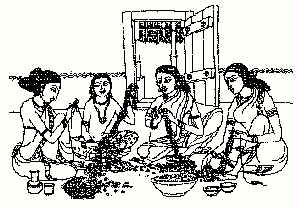
DECEMBER 21, YELLOW
The family sadhana for the first day of Pancha Ganapati is to create a vibration of love and harmony among immediate family members. The day begins early, and the entire family works together to design and decorate the shrine with traditional symbols, rangoli, lamps and more. Then a grand puja is performed invoking the spirit of Pancha Ganapati in the home. The sadhana of the day now begins. The family sits together for the purpose of easing any strained relationships that have arisen during the year. They make amends one with another for misdeeds performed, insults given, mental pain and injuries caused and suffered. When forgiveness is offered to all by one and all, they speak of each other’s good qualities and resolve that in the days ahead they will remember the futility of trying to change others and the practicality of changing oneself to be the silent example for all to witness. Gifts are then exchanged and placed unopened before Pancha Ganapati. As family harmony is important to all Hindus, this sadhana must be taken very seriously.
DECEMBER 22, BLUE
The family sadhana for the second day of Pancha Ganapati is to create a vibration of love and harmony among neighbors, relatives and close friends and presenting them with heartfelt. The sadhana of the day is to offer apologies and clear up any misunderstandings that exist. Relatives and friends in far-off places are written to or called, forgiveness is sought, apologies made and tensions released. Gifts received are placed unopened before Pancha Ganapati.
DECEMBER 23, RED
The family sadhana for the third day is to create a vibration of love and harmony among business associates, the casual merchant and the public at large. This is the day for presenting gifts to merchants and customers and to honor employers and employees with gifts and appreciation. The sadhana today is the settling of all debts and disputes. Gifts received are placed unopened before the Deity.
DECEMBER 24, GREEN
The sadhana of day four is to draw forth the vibration of joy and harmony that comes from music, art, drama and the dance. Family, relatives and friends gather for satsanga to share and enjoy their artistic gifts. When the program is over, all sit together before Pancha Ganapati, Patron of the Arts and Guardian of Culture, discussing Hindu Dharma and making plans to bring more cultural refinements into each household. More gifts are placed before Lord Ganapati.
DECEMBER 25, ORANGE
The family sadhana for the final day of Pancha Ganapati is to bring forth love and harmony within all three worlds. Because of sadhanas well performed during the first four days, the family is now more open and aware of Ganesha’s Grace, and their love for Him is now overflowing. On this day the entire family experiences an outpouring of love and tranquility from the great God Himself. His blessings fill the home and the hearts of everyone within it, inspiring them anew for the coming year. This exchange of affection between all members of the family and the Lord is invoked and perpetuated through the day by performing five special pujas. The first puja is at 6AM. Before the puja, personal offering trays are prepared and placed before His shrine. After the puja, each one gives verbal testimony about prayers that were answered during the past year. Hearing testimonies strengthens the faith of everyone. Then vows of sacrifice can be verbally made. Vows should improve the quality of the life of the individual, such as giving up smoking or correcting other harmful habits.
The second puja is at 9AM, and the third at 12 noon. The fourth puja is held at 3PM. At 6PM the fifth and final puja of the day is held. These five pujas to Pancha Ganapati solicit help from His devas in the home and establish the patterns for improvement in family life. The overflowing love that is felt today will inspire generosity in the year to come, bringing in return abundance and good fortune. All gifts received during the day are placed unopened before Pancha Ganapati.
The evening puja, held at six o’clock, is the long-awaited time. The five sadhanas have been completed. Peace, love and harmony among everyone have been restored. After the puja and before the great feast that follows, Lord Panchamukha Ganapati Himself gives His final darshana and prasada to one and all. Gifts are distributed and joyously opened. Happy children. Happy parents. Happy God.
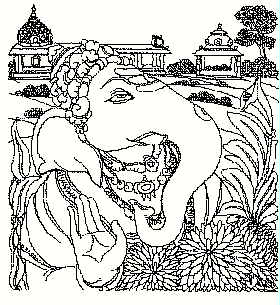
A FAMILY PRAYER AFTER PANCHA GANAPATI
Enjoy this prayer during the next 360 days after Pancha Ganapati. May His blessings flood your home with bounteous joy. May you and your family experience His boons of abundance, culture and sensitivity to the feelings of others that He will grant through the months ahead. Repeat the following prayer together after each puja in your shrine until Lord Ganesha returns again next year as Pancha Ganapati.
Om bhur bhuvah suvah
Ekadantaya vidmahe
Oh divine beings of all three worlds, let us bring our minds to rest in the darshana of Him who has one tusk.
Vakratundaya dhimahi
Let us meditate upon Him who has the form of an elephant with a curved trunk.
Tanno dantih prachodayat
May He guide us always along the right path.
Jai Ganesha!
Jai Panchamukha Ganapati!
Jai Ganesha! Jai! Jai!
Aum shantih, shantih, shantih, Aum.
Victory to the Lord of Celestials!
Hail to the Five-Faced Lord of ganas!
Victory to the Lord of Celestials!
Hail to Ganesha. Jai, jai.
Aum, peace, peace, peace, Aum.
Quite honestly, however, many Hindus still celebrate Christmas and often ask, “What’s wrong with that?” My answer is that it dilutes and weakens our noble Sanatana Dharma tradition and leads children astray. Most of those who do indulge in Christmas were educated in Christian schools. They do not, however, observe Jewish, Islamic or the many other similar gift-giving days. Each religion educates its young in a sectarian way, for religionists believe that to learn one specific path is sufficient and necessary. Education should not be diluted by taking in a Christian holiday or those of all religions under one banner. And by the way, most Hindus do not realize that Christmas is not really an ancient holiday, but was begun in America in the early 1900s and spread out through the world from there.
**Credits to and published by Himalayan Academy

